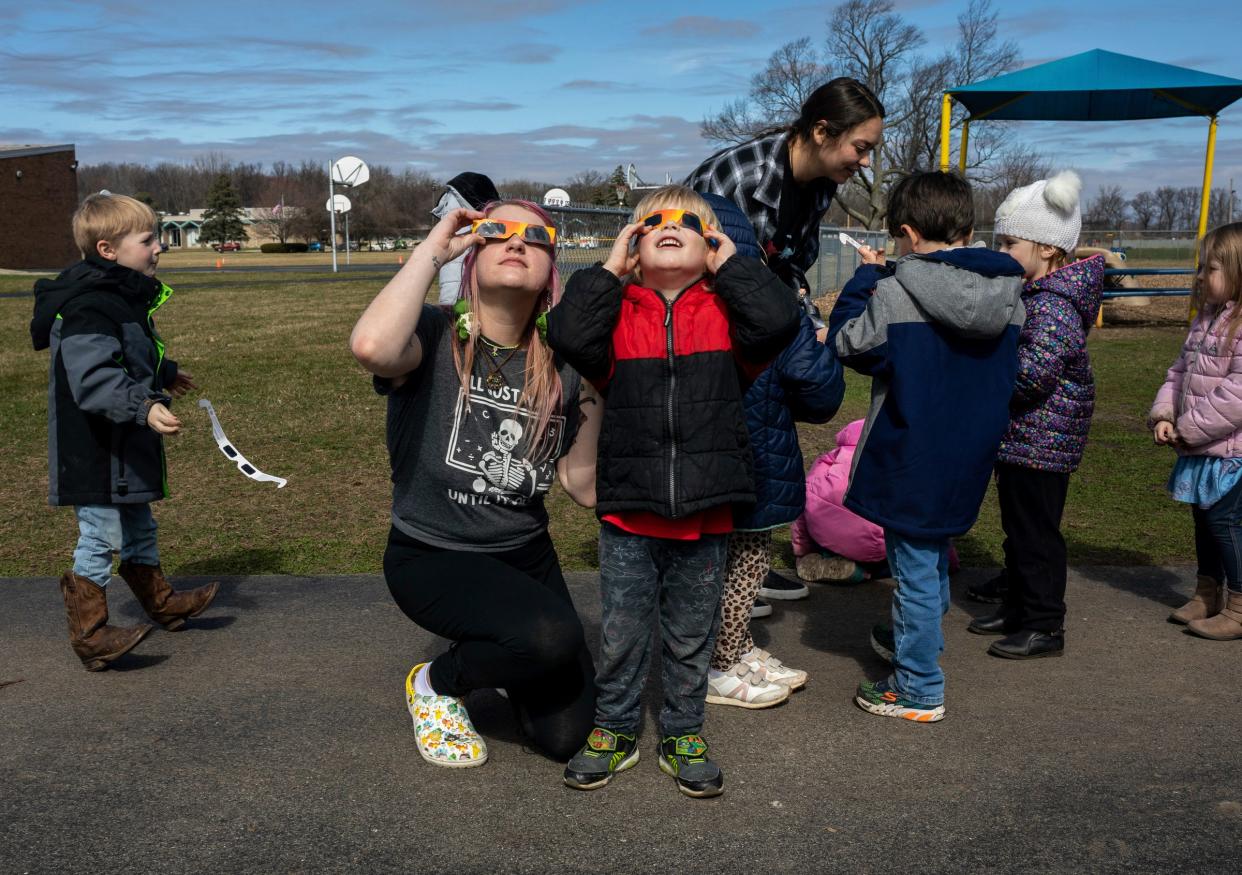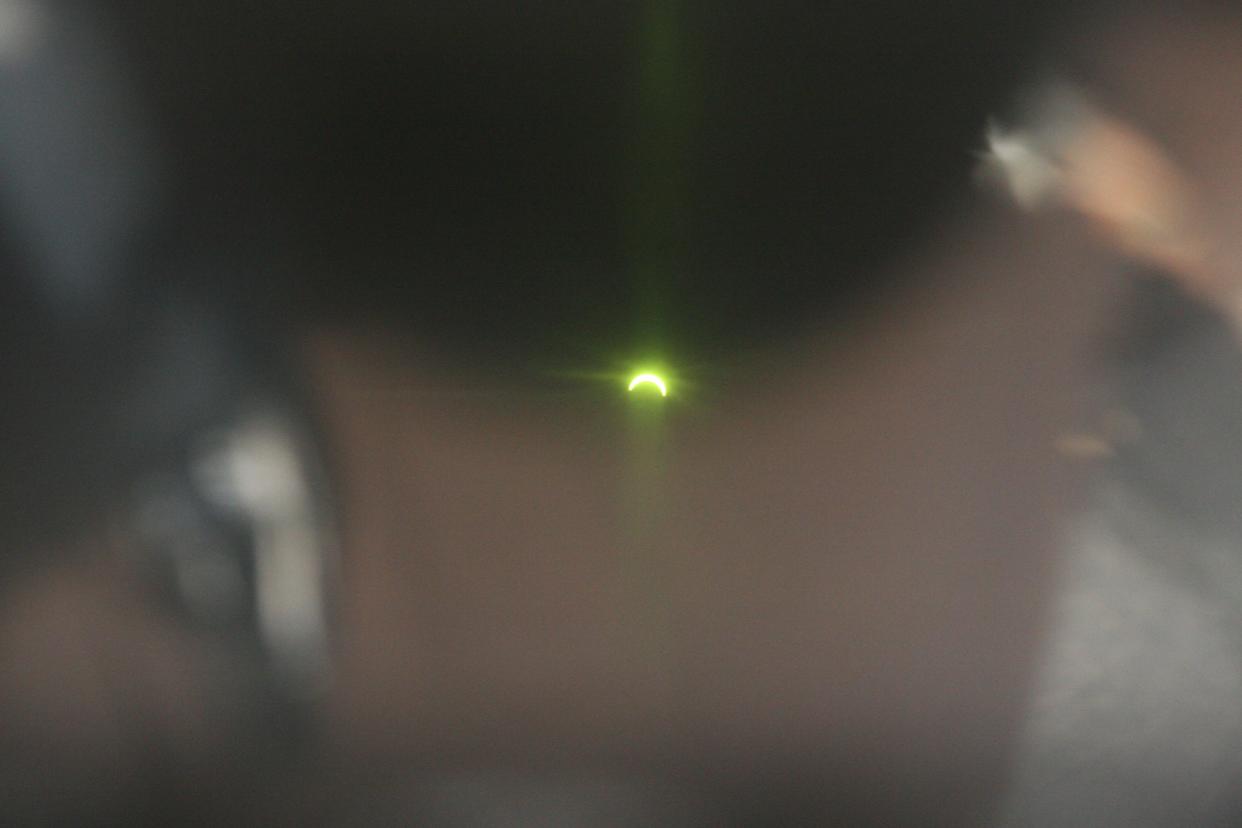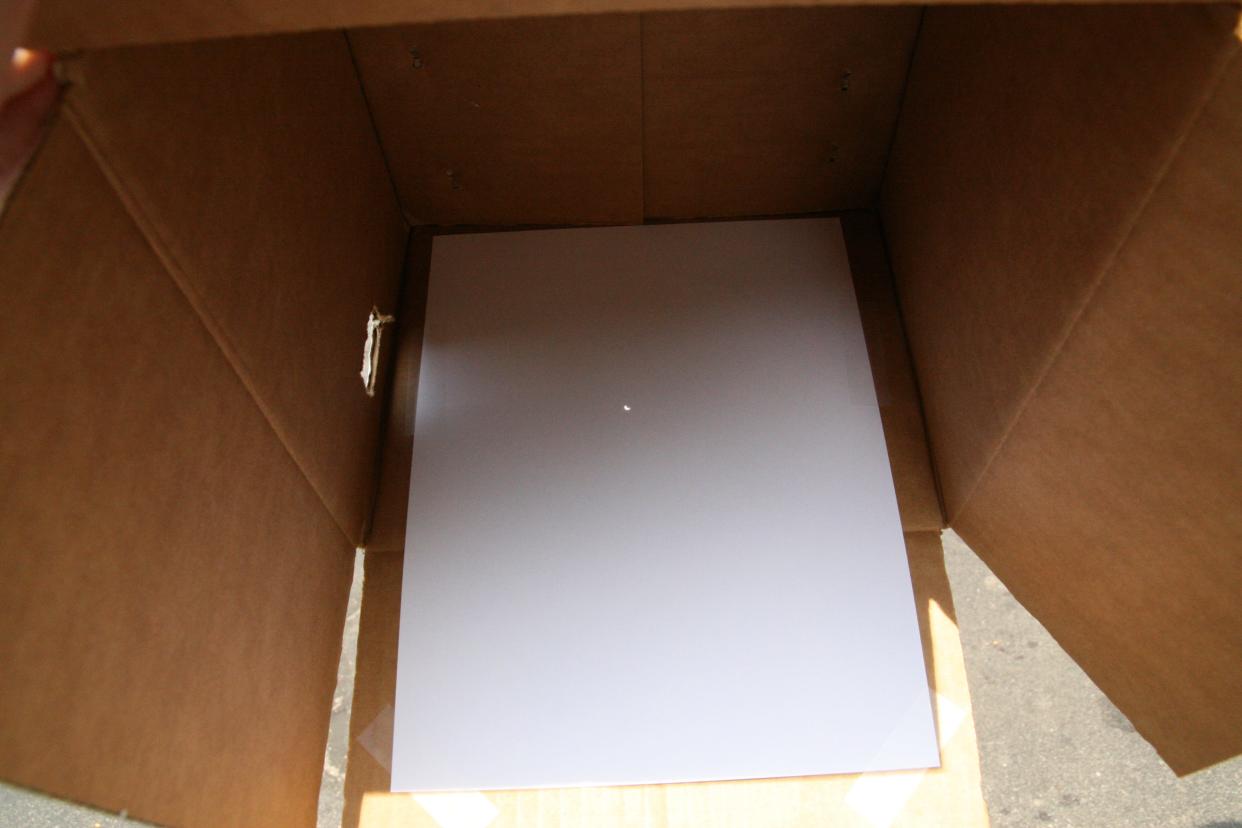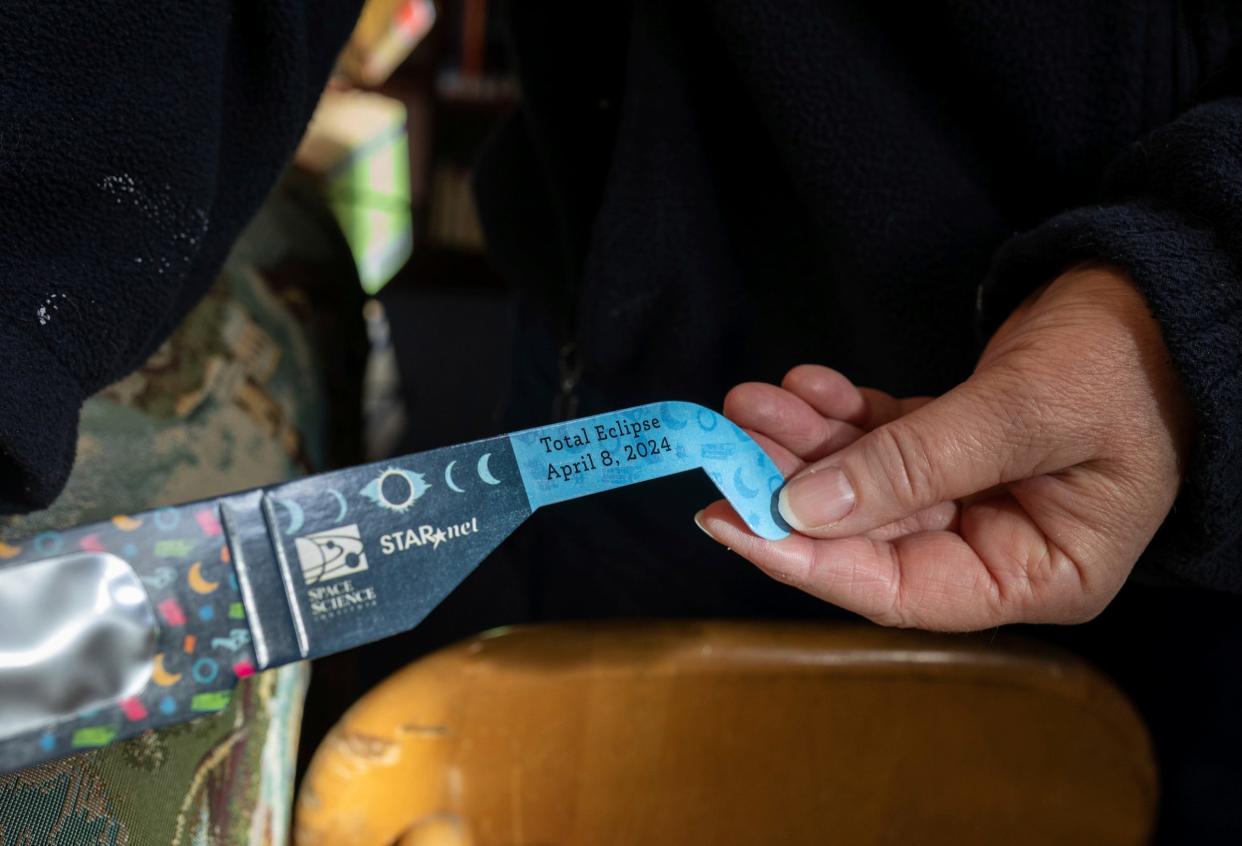Eclipse 2024: Prepare for once-in-a-lifetime total solar eclipse in Michigan
A dark time is coming — for about 34 seconds if you’re in Luna Pier at about 3:13 p.m. April 8.
That’s about how long the upcoming total solar eclipse will last.
For points north and west of the eastern end of the Ohio-Michigan state line, it’ll be less dark, just not nighttime dark. Even with more than 99% of the sun obscured by the moon, there will be enough daylight sneaking around the moon and reaching the Earth that it will be more like twilight. During the partial solar eclipse in 2017 that was visible in southern Michigan, it was like someone had connected the sun to a dimmer switch and turned it down a little.

Since the next total eclipse in the region won’t be for another 75 years, experts encourage people in southern Michigan to take advantage of the opportunity to watch it.
“Get thee to the path of totality,” University of Michigan astronomer and physicist David Gerdes said.
Mark Fairclough, director of the Robinson Planetarium at Adrian College, was in Hopkinsville, Kentucky, for the last total solar eclipse in 2017.
“Totality, it’s magnificent and it’s very strange. There’s nighttime darkness and birds and animals react to it,” he said last fall when discussing the annular eclipse that would have been visible in southern Michigan if not for rainy weather. “Birds head to their nests. Cats get very spooked. In Hopkinsville, we noticed even plants were reacting. All of nature kind of responds to this thing.”
For those in the path of totality, which includes that slice of Monroe County around Luna Pier as well as most of the metropolitan Toledo area, the effect will be like turning day into night. The temperature will drop by about 10 degrees. Streetlights likely will turn on. Stars will become visible. The sun’s corona should be visible around the moon, but only to those using the correct eclipse-viewing sunglasses.
In places near the center of the path of totality like Norwalk and Upper Sandusky, Ohio, the darkness will last for more than 3 minutes. This interactive map shows where the path of totality is and how much coverage people can expect outside of the path: tinyurl.com/JubierEclipseMap.
What is an eclipse?
There are two types of solar eclipses: annular and total.
“Both types of eclipses happen when the moon passes directly in front of the sun,” Gerdes said in a Q&A on the U-M website. “By an amazing cosmic coincidence, the moon’s diameter is 400 times smaller than the sun, and the sun is about 400 times farther away. So, as seen from Earth, they have almost the same apparent size, and the moon can almost exactly cover the sun. But the moon’s orbit isn’t perfectly circular. Its apparent diameter varies by about 12% as it moves around its elliptical orbit. This is enough to make a difference between fully covering the sun (a total eclipse) and not-quite-covering the sun (an annular, or ‘ring of fire,’ eclipse). Because the sun isn’t completely covered in an annular eclipse, the spectacular sights of a total eclipse — the delicate solar corona, darkness in the middle of the day, 360-degree twilight around the horizon — are not visible.
“Fortunately for us, the April 8, 2024, total eclipse will occur when the moon’s apparent size is near its maximum, so people in the path of totality will be treated to a total eclipse that lasts over four minutes, nearly twice as long as the total eclipse of 2017.”
Safety first
The most important thing to remember about watching the eclipse is to not look directly at the sun. Looking at the sun can cause permanent damage to the retina called solar retinopathy.

“Viewing can’t be done safely without eye protection. You will damage or destroy your eye or go blind looking at an eclipse. You must use eye protection. We’re not talking about sunglasses, but shielding protection, like welder’s glasses. You can easily purchase, for a minuscule amount, solar eye protection,” Fairclough said.
To safely look at the eclipse, use glasses made with ISO 12312-2 certified solar filters. Shade 14 welder’s glass is OK, too.
The American Astronomical Society maintains a list of online and brick-and-mortar retailers that are selling certified glasses at eclipse.aas.org/eye-safety. Warby Parker will be giving away free glasses — limit two per person — at its stores starting April 1. There is a store in Ann Arbor. Stores selling the glasses include 7-Eleven, Meijer, Kroger, Walmart, Menards, Lowe’s and Staples.
Many of the glasses look like old-fashioned 3-D movie glasses and cost about $2 per pair.

Other options include using a pinhole viewer. Anything with small holes in it would work, such as a colander. Even just using one’s hands to create small gaps that let light through would work. Instead of looking at the sun, the viewer is used to project the sunlight onto another surface to watch the show.
A pinhole viewer can be made with a box, a piece of paper and some tape. Poke a small hole in one side of the box and tape the paper to the inside, opposite side of the box. During the eclipse, point the side of the box with the hole toward the sun and look at the paper to see the moon cross in front of it.
Even the sunlight shining through leaves of trees can make cool, crescent-shaped shadows on the ground.

Photographers will want to take care when trying to capture images of the eclipse, too.
“To photograph the partial phases, you must place a solar filter in front of your camera lens,” Gerdes said. “The sun is actually really small, so detailed photos of the corona require a long zoom or telephoto lens. The corona is also very high-contrast, so use manual settings and choose a range of exposure times.”
Gerdes also recommends setting up a camera on a tripod to capture video of the event.
“The moment of totality can set off a profound reaction among the participants, and often the best part of a video is the audio,” he said.
For eclipse newbies, it might be best to just sit back and enjoy the show.
“If this will be your first total eclipse, my best advice is to simply put your camera down and allow yourself to be fully present for the awesome sights and sounds of totality,” Gerdes said. “There will be many outstanding photographs of this eclipse, but your experience and memories will be your own.”
Local events
If you plan to stay close to home to watch the eclipse, there are some events planned.
• Lake Hudson Recreation Area, 5505 Morey Highway, Clayton: 1:30 to 4:30 p.m. The state park in western Lenawee County will host a family-friendly viewing party in the beach area. Visit Lenawee will provide solar eclipse glasses to everyone while supplies last. A recreation passport is required to enter state parks.
• Erie State Game Area, Erie Township: 2 to 4 p.m. The Dusseau Tract of the Erie State Game Area is at the corner of Dean Road and Bay Creek Road. Parking is available in a couple of small parking areas and along the grass shoulder of Bay Creek Road. There will be an area out in the field where visitors can bring chairs and blankets. They also can sit along the top of the dike wall to the south of the Dusseau tract. All general state game area rules apply.
• Bedford Hills Golf Club, 6400 Jackman Road, Temperance: The club’s parking lot will be open to the public, with a limited number of free viewing glasses provided by the Monroe County Convention & Tourism Bureau. There will be a sno-cone and smoothie truck and other food and drinks available.
• River Raisin National Battlefield Park Visitor Center, 333 N. Dixie Highway, Monroe: Noon to 5 p.m. A livestream of the eclipse will be shown in the theater from noon to 3:30 p.m. Family events will take place from 3:15 to 4:30 p.m. in the events center. The Eclipse Explorer Junior Ranger Program from 10 a.m. to 5 p.m. offers a limited supply of free viewing glasses.
• “Total Eclipse on the Farm,” Kackleberry Farms, 6421 N. Stoney Creek Road, Monroe: 1 to 7 p.m. $20 admission; not recommended for young children or anyone who cannot follow safe viewing guidelines. Limited tickets available. $20 admission to the farm includes access to activities on the farm, a hay wagon ride, farm animals, eclipse viewing glasses, and a galaxy-themed snack pack. Events also are planned on Saturday and Sunday, also with $20 admission. Buy tickets online at www.kackleberryfarms.com/tickets.
• Sterling State Park, 2800 State Park Road, Monroe: 1:30 to 4:30 p.m. Free glasses will be provided, while supplies last, courtesy of the Monroe County Convention & Tourism Bureau, Monroe County Museum System and Michigan Department of Natural Resources. Food trailers, interpretive programs, Monroe County Sheriff ‘s Office and Michigan State Police Monroe Post community engagement and recruiting, and a touch-the-truck DNR equipment display are planned.
• The Quarry, 15625 Hull Road, Monroe: Eclipse viewing party begins at 1 p.m. and includes specialty drinks and eclipse glasses.
• Monroe County/Toledo North KOA Holiday, 15600 Tunnicliffe Road, Petersburg: The campground is opening early for the season to allow guests to view the eclipse.
Subscribe Now: For all the latest local developments, breaking news, and high school and college sports content.
Despite being in the path of totality, Luna Pier opted to not have any big events due to construction on I-75 that is limiting the flow of traffic in and out of the city.
Updated lists of events are at www.visitlenawee.com/2024-solar-eclipse and visitmonroemi.us/2024-solar-eclipse.
There are several events scheduled in the Toledo area. Those are listed on the Destination Toledo website at www.visittoledo.org/eclipse.
Influx of visitors?
Communities within the path of totality have been expecting to see an increase in tourism business around the eclipse. Justin Gifford, executive director of Visit Lenawee, said hotels in the Toledo area have been booking visitors for the eclipse since before the first of the year, especially from some of the larger universities in southern Ohio.
Anyone looking to book a hotel room during the eclipse weekend can still find places in the Toledo area as well as Monroe, Dundee and Adrian, according to searches of online booking sites.
“We anticipate that we'll continue to see an influx of reservations come in to both counties, but more so Monroe County just due to their proximity to the total eclipse line that NASA has projected,” Gifford said.
Visit Lenawee and the Monroe County Convention & Tourism Bureau are partners in promoting tourism in both counties.
Will we even see it?
Maybe you’ve seen a meme making the rounds on social media about how whenever there’s a rare, celestial event — a comet, meteor shower, alien spaceship — Michiganders miss out because it’s cloudy. Viewing of last fall’s annular solar eclipse was washed out by overcast, rainy weather.
Accuweather has its long-range forecast out, and it’s showing there will be periods of sun and clouds with no rain on April 8, which should make for good viewing. However, that same forecast shows rain on the April 7 and 9, so if the weather pattern speeds up or slows down a little, the chances of seeing the eclipse could plummet.
For those of us wanting to experience this once-in-a-lifetime event in its, ahem, totality, let’s hope the forecast without rain holds.
— Contact reporter David Panian at dpanian@lenconnect.com or follow him on X, formerly Twitter: @lenaweepanian.
This article originally appeared on The Daily Telegram: Solar eclipse 2024 viewing guide for Monroe, Adrian, Hillsdale
